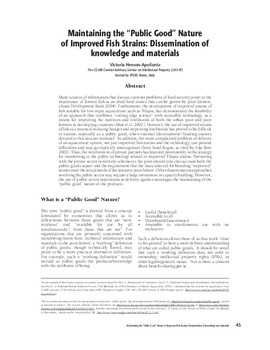Please use this identifier to cite or link to this item:
https://hdl.handle.net/20.500.12348/1866
Maintaining the "public good" nature of improved fish strains: dissemination of knowledge and materials
| dc.creator | Henson-Apollonio, V. | |
| dc.date.accessioned | 2018-11-19T13:03:33Z | |
| dc.date.available | 2018-11-19T13:03:33Z | |
| dc.date.issued | 2006 | |
| dc.identifier.citation | p. 45-50. In Ponzoni, R.W. ; Acosta, B.O. ; Ponniah, A.G. (eds.) Development of aquatic animal genetic improvement and dissemination programs: current status and action plans. WorldFish Center Conference Proceedings 73. Penang, Malaysia. 120 p. | |
| dc.identifier.uri | https://hdl.handle.net/20.500.12348/1866 | |
| dc.description.abstract | Many sources of information that discuss currents problems of food security point to the importance of farmed fish as an ideal food source that can be grown by poor farmers, (Asian Development Bank 2004). Furthermore, the development of improved strains of fish suitable for low-input aquaculture such as Tilapia, has demonstrated the feasibility of an approach that combines “cutting edge science” with accessible technology, as a means for improving the nutrition and livelihoods of both the urban poor and poor farmers in developing countries (Mair et al. 2002). However, the use of improved strains of fish as a means of reducing hunger and improving livelihoods has proved to be difficult to sustain, especially as a public good, when external (development) funding sources devoted to this area are minimal1. In addition, the more complicated problem of delivery of an aquaculture system, not just improved fish strains and the technology, can present difficulties and may go explicitly unrecognized (from Sissel Rogne, as cited by Silje Rem 2002). Thus, the involvement of private partners has featured prominently in the strategy for transferring to the public technology related to improved Tilapia strains. Partnering with the private sector in delivery schemes to the poor should take into account both the public goods aspect and the requirement that the traits selected for breeding “improved” strains meet the actual needs of the resource poor farmer. Other dissemination approaches involving the public sector may require a large investment in capacity building. However, the use of public sector institutions as delivery agents encourages the maintaining of the “public good” nature of the products. | |
| dc.format | application/pdf | |
| dc.language | En | |
| dc.publisher | WorldFish Center | |
| dc.rights | CC BY 4.0 | |
| dc.title | Maintaining the "public good" nature of improved fish strains: dissemination of knowledge and materials | |
| dc.type | Conference Paper | |
| dcterms.bibliographicCitation | Henson-Apollonio, V. (2006). Maintaining the "public good" nature of improved fish strains: dissemination of knowledge and materials. p. 45-50. In Ponzoni, R.W. ; Acosta, B.O. ; Ponniah, A.G. (eds.) Development of aquatic animal genetic improvement and dissemination programs: current status and action plans. WorldFish Center Conference Proceedings 73. Penang, Malaysia. 120 p. | |
| cg.identifier.worldfish | 2459 | |
| cg.subject.agrovoc | aquaculture | |
| cg.subject.agrovoc | breeding | |
| cg.subject.agrovoc | farmers | |
| cg.subject.agrovoc | food security | |
| cg.subject.agrovoc | genetics | |
| cg.subject.agrovoc | livelihoods | |
| cg.subject.agrovoc | partnerships | |
| cg.subject.worldfish | fish food system | |
| cg.identifier.status | Open access | |
| cg.description.theme | Sustainable aquaculture |
Files in this item
This item appears in the following Collection(s)
-
Sustainable aquaculture [2735]
